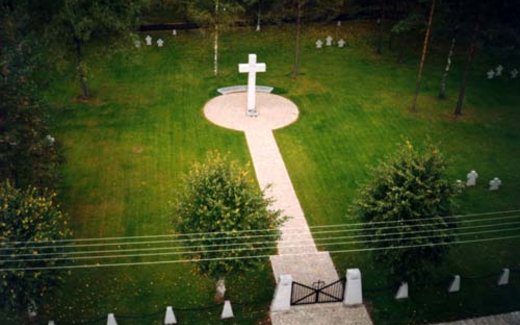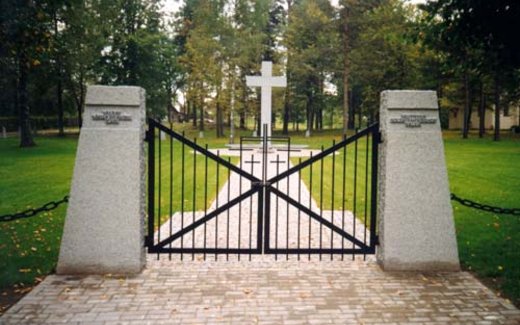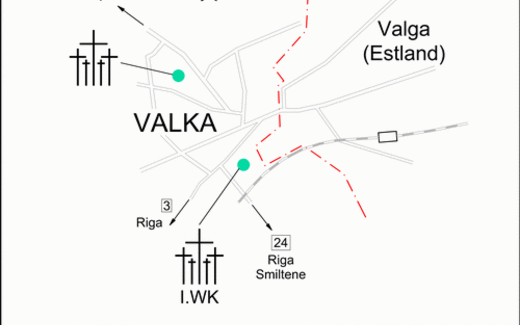The war cemetery with the dead of the Second World War is part of the
Forest cemetery (Meza Kapi) in the town of Valka (German: Walk), which lies directly on the
Border with Estonia.
Cemetery description
The 4,770 square meter war cemetery comprises three sections and borders a Latvian military cemetery
adjacent to a Latvian military cemetery from 1919/20 and a cemetery with civilian
with civilian dead. A boundary made of natural stone posts visually unites the
into a single visual unit. Visitors enter the cemetery through a
The cemetery through a wrought-iron gate, the border of which bears the name of the
Cemetery in German and Latvian. Nine groups of crosses made of natural stone
make the cemetery visible. They are located near the
Cemetery chapel.
A five-metre-high stone cross stands on the circular central square
Stone cross. Behind it are plaques inscribed with the names of the dead, their dates of birth
Dates of birth and death as well as ranks.
Occupancy
After the First World War, the Baltic states gained independence
Independence. After the Estonian army drove out the Bolsheviks in the spring of 1919
latvia also laid claim to Walk. In 1920, the town was divided into two parts
divided. A district in the south-west came to Latvia, while the center and the railway station
Station fell to Estonia. Valka was granted city rights in 1922.
During the Second World War, heavy fighting took place north of the town in 1944.
Between 1943 and 1944, almost 400 German soldiers found their final resting place in Valka
Resting place.
According to the Volksbund Deutsche Kriegsgräberfürsorge e. V. (German War Graves Commission)
Latvia during the Second World War, around 100,000 German soldiers lost their
And were buried at around 6,600 grave sites. From the First
World War I resulted in 210 war cemeteries with around 30,000 grave sites.
History
Even before Latvia's political independence, there was contact between the
the city administration of Riga and the German War Graves Commission e. V.
came about. As a result, a German prisoner of war cemetery was opened in Riga in 1991
prisoner of war cemetery was inaugurated in Riga in 1991 - the first project that the
the former Soviet Union. Since then, it has opened several
Cemeteries of the Second World War - including the Valke war cemetery
Valke war cemetery, which was opened to the public on September 19, 1998
to the public on September 19, 1998.
In addition, more than 30 war cemeteries from the First World War have been restored with the
Restored with the help of volunteers at work camps and Bundeswehr missions.
The war graves agreement between Germany and Latvia dates from January 24, 1996.
The Volksbund's partner is the "Brothers' Cemeteries Committee" in Riga
Riga.
Special feature
There is also a cemetery in Valka with 60 German dead from the First World War
World War. It consists of a communal grave with a granite memorial with the inscription
Granite monument with the inscription "GERMAN WAR GRAVE 1914 - 1918 | HERE REST 46
GERMAN WARRIORS | THEY ALL DIED IN FAITHFUL FULFILLMENT OF DUTY FOR THEIR
FATHERLAND | HONOR THEIR MEMORY. 1939"
Seven concrete slabs list names, units and dates of death and - unlike the memorial
39 known and 21 unknown dead. The war cemetery
war cemetery is part of the "Cimzes Kapi" cemetery, which is named after the
named after the Livonian educator and musician Jânis Cimze.


